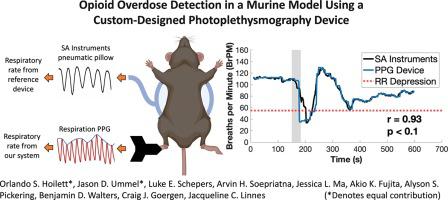IRBM ( IF 4.8 ) Pub Date : 2023-07-25 , DOI: 10.1016/j.irbm.2023.100792 Orlando S. Hoilett , Jason D. Ummel , Luke E. Schepers , Arvin H. Soepriatna , Jessica L. Ma , Akio K. Fujita , Alyson S. Pickering , Benjamin D. Walters , Craig J. Goergen , Jacqueline C. Linnes

|
Background and Objective
Over 68,000 opioid-overdose related deaths occurred within the United States in 2020 alone, indicating a need to develop technologies to help curb this growing epidemic. The ability to detect respiratory rate (RR) depression in real-time has the potential to decrease adverse outcomes by alerting emergency medical services or willing bystanders to an overdose event. The aim of this investigation was to design, build, and test a novel photoplethysmography (PPG)-based measurement device capable of monitoring RR and identifying respiratory depression.
Materials and Methods
We developed a novel murine model for opioid-induced respiratory depression (OIRD) to demonstrate the PPG device's capabilities. We induced respiratory depression in mice using both isoflurane and opioid-overdose and initiated recovery events with injections of naloxone while monitoring respiration via PPG and a laboratory reference system.
Results and Discussion
The device accurately identified all anesthesia-induced respiratory depression (n = 5) and OIRD events (n = 3). Our PPG-based monitor showed significant correlation with a reference respiratory measurement system (). The bias measured across the isoflurane trials was 0.6 breaths per minute (BrPM), while the bias measured across the oxycodone trials was −1.0 BrPM, with mean absolute errors of 1.5 and 3.6 BrPM, respectively, indicating that our device was able to accurately measure RR in a murine model.
Conclusions
These preliminary experiments suggest that our device could detect OIRD and could potentially be adaptable to humans with modifications to firmware and more extensive validation in human subjects. Our present study is a proof-of-concept for detecting OIRD and alerting bystanders and health professionals in real-time.
中文翻译:

使用定制设计的光电体积描记装置检测小鼠模型中的阿片类药物过量
背景和目的
仅 2020 年,美国境内就发生了超过 68,000 起阿片类药物过量相关死亡事件,这表明需要开发技术来帮助遏制这一日益严重的流行病。实时检测呼吸频率(RR)抑制的能力有可能通过向紧急医疗服务机构或愿意的旁观者发出药物过量事件的警报来减少不良后果。本研究的目的是设计、构建和测试一种新型的基于光电体积描记法 (PPG) 的测量设备,该设备能够监测 RR 并识别呼吸抑制。
材料和方法
我们开发了一种新型阿片类药物引起的呼吸抑制 (OIRD) 小鼠模型,以展示 PPG 设备的功能。我们使用异氟烷和阿片类药物过量诱导小鼠呼吸抑制,并通过注射纳洛酮启动恢复事件,同时通过 PPG 和实验室参考系统监测呼吸。
结果与讨论
该设备准确识别了所有麻醉引起的呼吸抑制 (n = 5) 和 OIRD 事件 (n = 3)。我们基于 PPG 的监测仪显示出与参考呼吸测量系统的显着相关性()。异氟醚试验测量的偏差为每分钟 0.6 次呼吸 (BrPM),而羟考酮试验测量的偏差为 -1.0 BrPM,平均绝对误差分别为 1.5 和 3.6 BrPM,表明我们的设备能够准确测量小鼠模型中的 RR。
结论
这些初步实验表明,我们的设备可以检测 OIRD,并且通过修改固件和在人类受试者中进行更广泛的验证,有可能适用于人类。我们目前的研究是检测 OIRD 并实时向旁观者和卫生专业人员发出警报的概念验证。



























 京公网安备 11010802027423号
京公网安备 11010802027423号